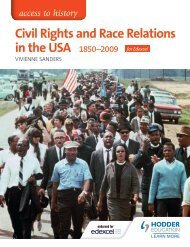SAMPLE
Sample-chapter-for%20Early-Elizabethan-England,-1558-1588,-Student-Book
Sample-chapter-for%20Early-Elizabethan-England,-1558-1588,-Student-Book
Create successful ePaper yourself
Turn your PDF publications into a flip-book with our unique Google optimized e-Paper software.
1.1 The situation on Elizabeth’s accession<br />
Learning outcomes<br />
••<br />
Understand the structure of Elizabethan society in 1558.<br />
••<br />
Understand the circumstances Elizabeth I found herself in when she came to the throne, including the issue of<br />
her legitimacy.<br />
••<br />
Understand the challenges Elizabeth faced, both at home and abroad, during the early years of her reign.<br />
01 Queen, government and<br />
religion, 1558–69<br />
If you were 16 in 1558, when Elizabeth I became queen, you would have<br />
already outlived at least 21% of those born in the same year as you. You<br />
might also be fast approaching the half-way point of your life, as the average<br />
life expectancy was between 28 and 41.<br />
In those 16 years, hundreds of people would have been put to death by<br />
the English government. It is likely that you would have heard about, or<br />
even witnessed, the agonies of those being burned alive for their religious<br />
beliefs. Holding religious beliefs different from the monarch’s was extremely<br />
dangerous. Since the reign of Henry VIII, religion in England had changed<br />
with every new king or queen. From November 1558, England’s religion was<br />
decided by Elizabeth I.<br />
Traitors also faced execution. Elizabeth had herself been imprisoned as a<br />
traitor in the Tower of London in 1554. She was suspected of treason against<br />
her sister, Mary I. After becoming queen herself, Elizabeth often found her life<br />
threatened by plots.<br />
Elizabeth was 25 when she took the throne. Her first task was to secure her<br />
position as queen. To do so she arranged her coronation for January 1559 and<br />
then drew up her plans for England’s religion. By doing these things, Elizabeth<br />
would be the ultimate source of political and religious power in England.<br />
Draft material<br />
Learning outcomes<br />
By the end of this chapter, you will:<br />
••<br />
know and understand how English society and government were organised<br />
••<br />
know and understand what problems Elizabeth faced on becoming queen<br />
••<br />
know and understand how Elizabeth dealt with the problems caused by<br />
England’s religion<br />
••<br />
know and understand why Mary, Queen of Scots, was a threat to Elizabeth.<br />
Society and government in 1558<br />
Elizabethan England was often a violent and dangerous<br />
place. As there was no police force or permanent army,<br />
keeping order relied upon a clear social structure in<br />
which everyone knew their place and had a role. Equality<br />
was not something that was important to Elizabethans.<br />
In fact, society, government, and law and order were<br />
based on inequality.<br />
Society<br />
Elizabethans had a very clear idea of where everyone<br />
belonged in society. The monarch was at the top of<br />
the social scale as the most important member of the<br />
nobility, followed by the rest of the nobility and gentry.<br />
Your place in this hierarchy was generally determined<br />
by how much land you had and whether you owned<br />
or rented it. About 90% of England’s population lived<br />
and worked in the countryside. Yeomen were men who<br />
held a small amount of land or an estate – they were<br />
essentially lower gentry. Tenant farmers farmed rented<br />
land, which was usually owned by yeomen or the gentry.<br />
Nobility<br />
Gentry<br />
Merchants<br />
Often owned a lot of property<br />
Professionals<br />
Lawyers, clergy, doctors, teachers<br />
Business owners<br />
Usually highly skilled craftsmen<br />
Employed others<br />
In towns, the hierarchy was based on wealth and<br />
occupation. Wealthy merchants were at the top,<br />
followed by professionals, such as lawyers and doctors.<br />
Next came skilled craftsmen, such as silversmiths,<br />
glovers, carpenters or tailors, who could be quite<br />
wealthy business owners. They organised themselves<br />
into guilds, which were trade associations to monitor<br />
standards, working conditions and who were allowed to<br />
practise the trade. Craftsmen were skilled employees,<br />
and also included apprentices. Unskilled labourers and<br />
the unemployed came at the bottom of society.<br />
Wherever you were in Elizabethan society, you owed<br />
respect and obedience to those above you and had a<br />
duty of care to those below you. Landowners ran their<br />
estates according to these ideas. Ideally they would<br />
take care of their tenants, especially during times of<br />
hardship.<br />
Households were run along similar lines to society. The<br />
husband and father was head of the household. His wife,<br />
children and any servants were expected to be obedient<br />
to him.<br />
Draft material<br />
Yeomen<br />
Tenant farmers<br />
Landless or labouring poor<br />
Vagrants, homeless<br />
Skilled craftsmen<br />
People who had learned<br />
a skill or trade<br />
Unskilled workers and the unemployed<br />
The social hierarchy of Elizabethan England<br />
The social hierarchy of towns in Elizabethan England<br />
Figure 1.1 Elizabethan society was a hierarchy in which everyone had a clear place in the social order.<br />
9




